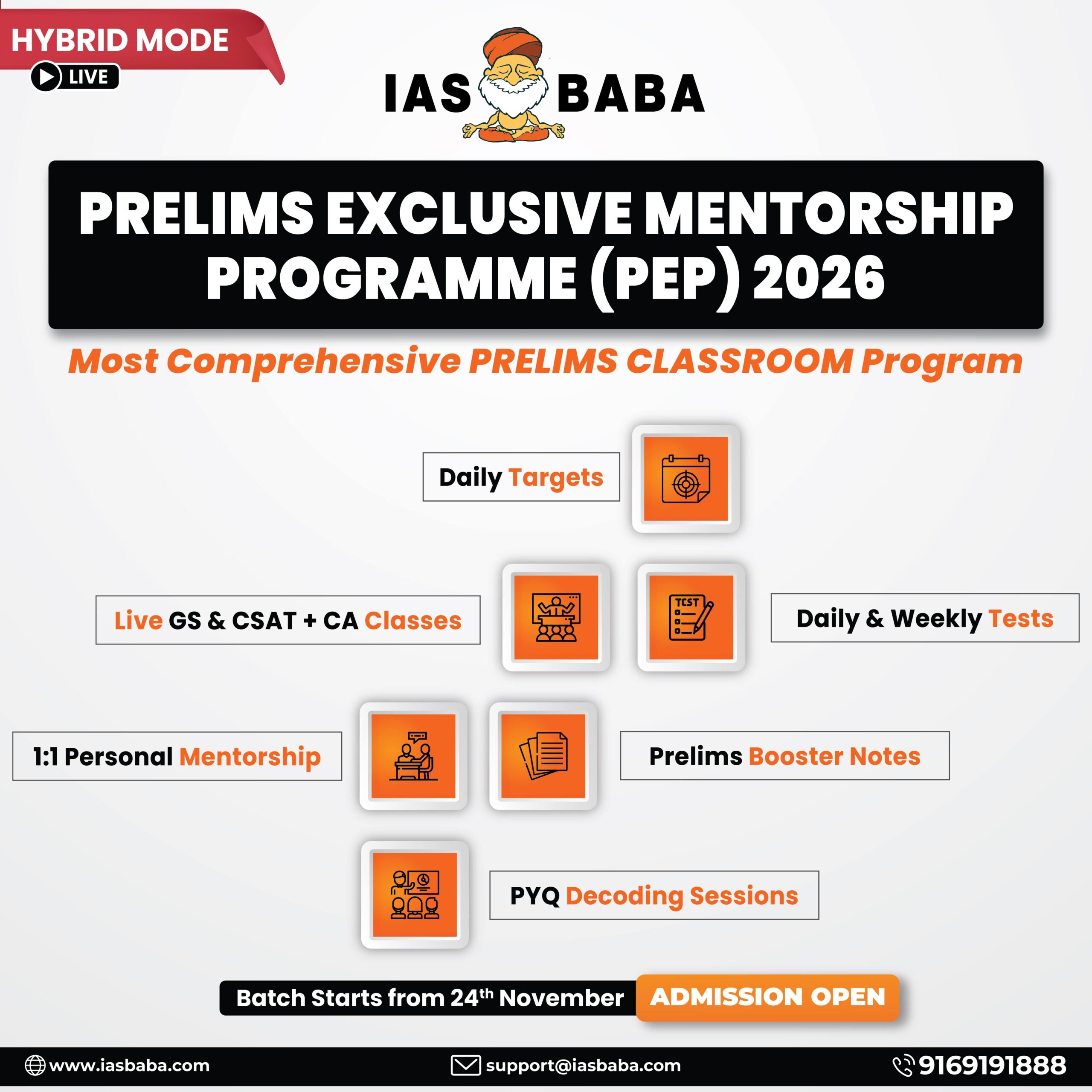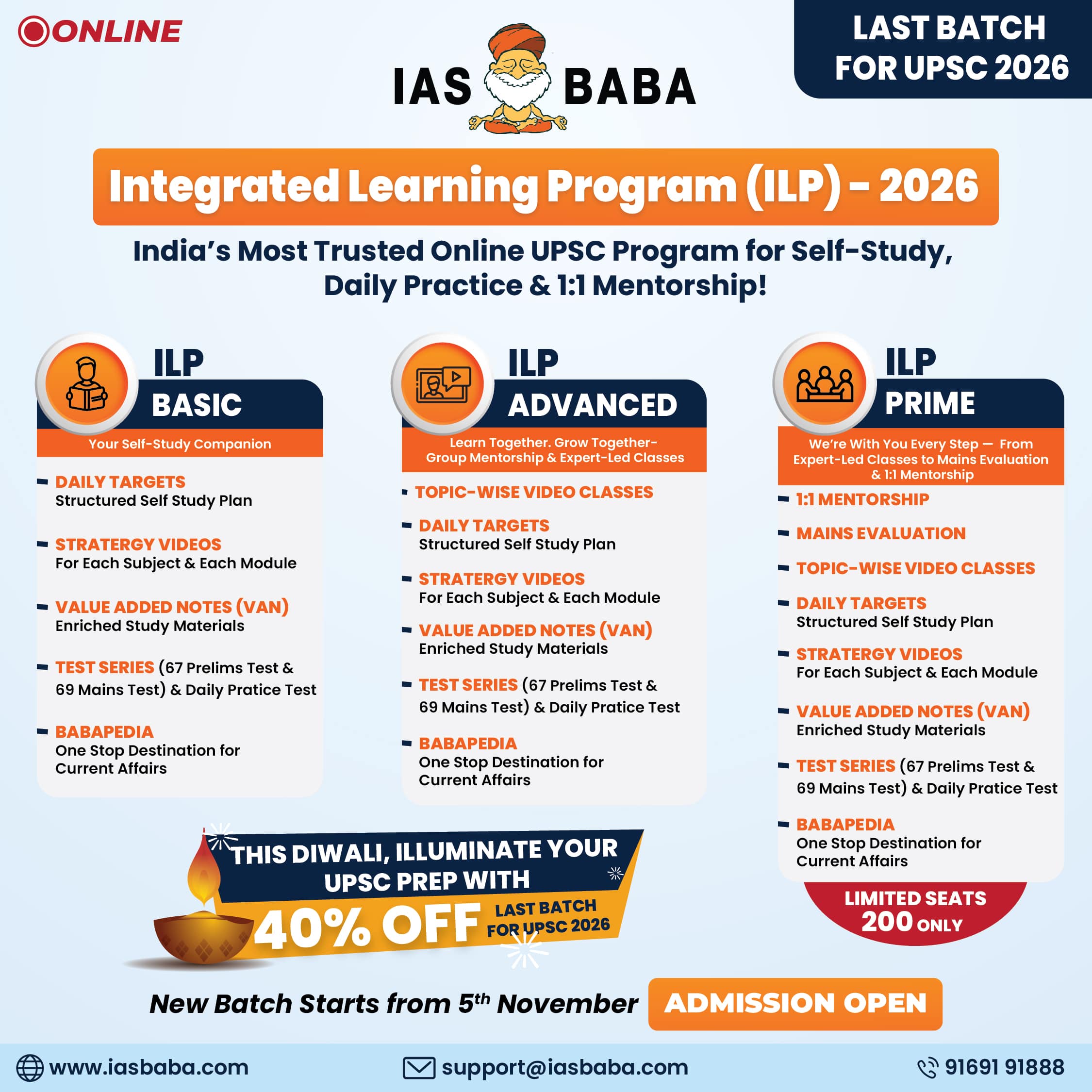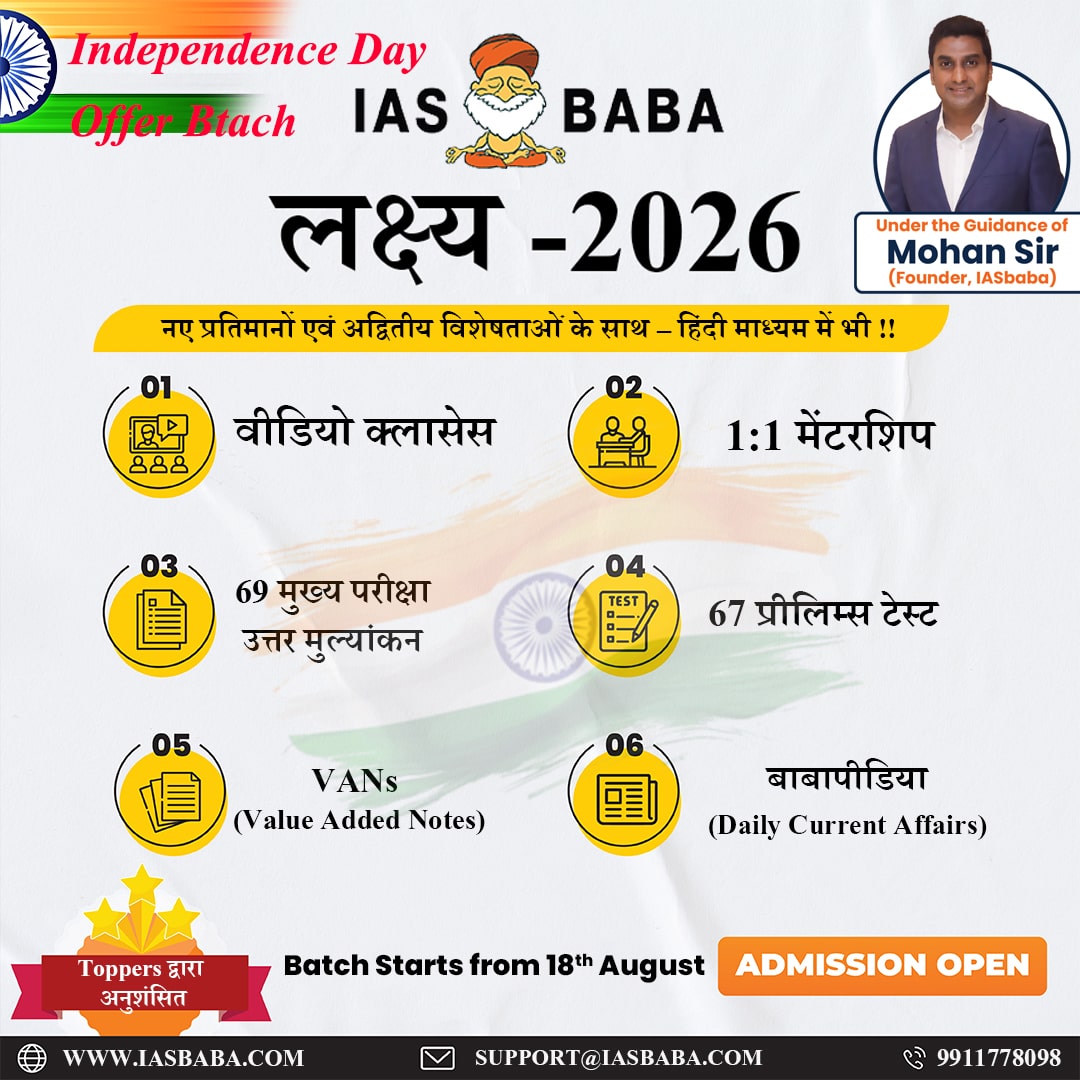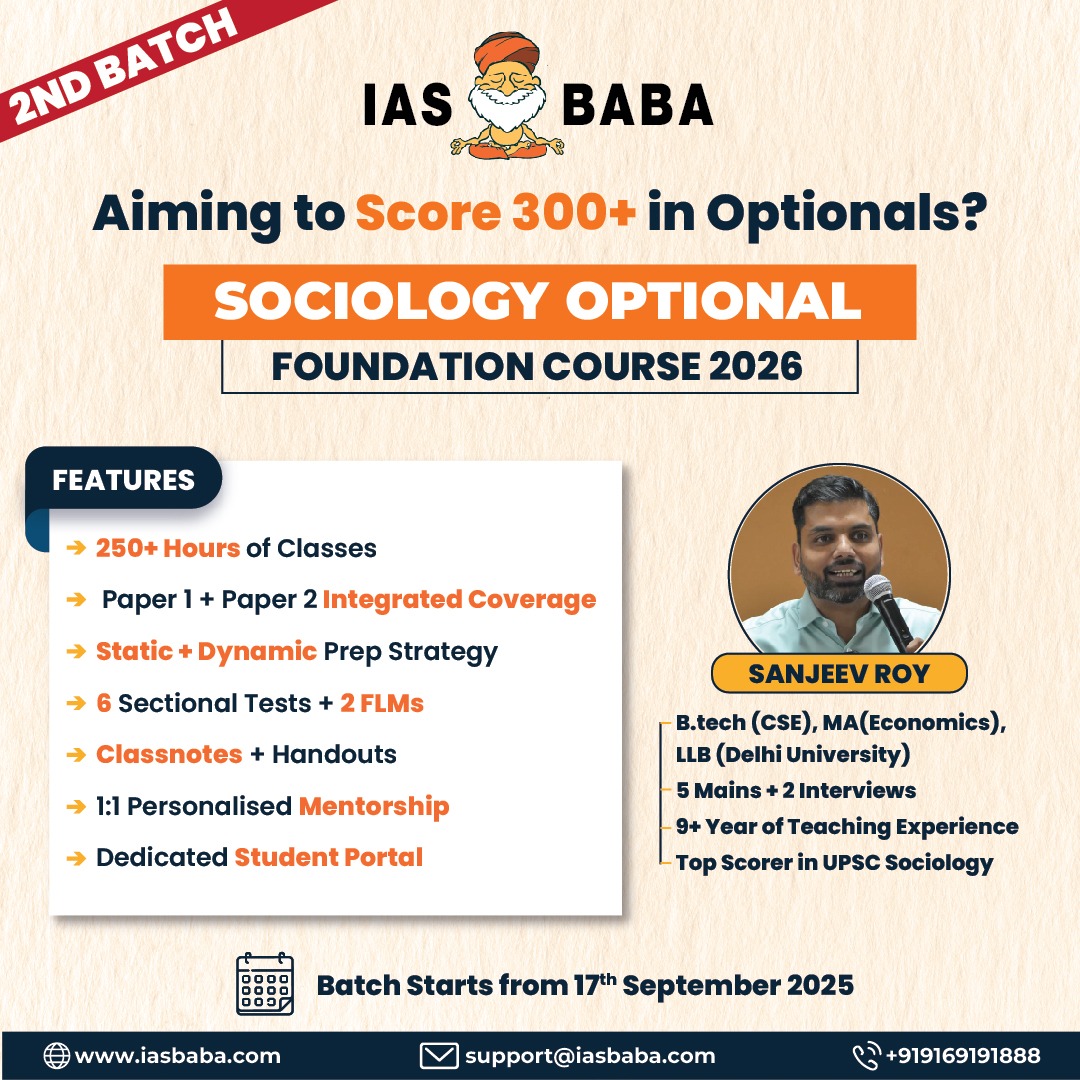IASbaba's Daily Current Affairs Analysis
Archives
(PRELIMS Focus)
Category: INTERNATIONAL
Context: A senior official from the Ministry of External Affairs (MEA) warned that escalating tensions in West Asia could delay IMEC’s rollout.
Ongoing instability in the region — involving players like Israel, Palestine, Iran, and others — is causing uncertainty for large infrastructure investments.
Learning Corner:
West Asia Crisis and IMEC: What You Need to Know
What is IMEC?
- India-Middle East-Europe Economic Corridor (IMEC) is a strategic connectivity project designed to link India with Europe via the Middle East.
- Envisioned to enhance trade, digital connectivity, and energy flows.
- Considered a counterweight to China’s Belt and Road Initiative (BRI).
Implications for India
- Trade Disruption: Delayed implementation could affect supply chain connectivity and trade between India, the Middle East, and Europe.
- Strategic Setback: It may hinder India’s broader geopolitical strategy of regional influence and global supply chain diversification.
- Investment Concerns: Infrastructure and investor confidence could weaken amid ongoing unrest.
India’s Stance
- India continues to support IMEC and remains diplomatically engaged with partner nations.
- Stresses the need for regional peace and stability as essential conditions for progress.
- The government is actively monitoring the situation and pursuing diplomatic efforts to de-escalate tensions.
Source : THE HINDU
Category: ENVIRONMENT
Context India introduced a policy allowing 15% concessional import duty on fully built electric vehicles (EVs), provided manufacturers invest ₹4,150 crore over three years in local manufacturing.
- The policy mandates:
- 25% domestic value addition (DVA) within 3 years.
- 50% DVA by the 5th year.
- Permission to import up to 8,000 EVs annually per manufacturer for 5 years.
- This is governed by the Scheme to Promote Manufacturing of Electric Passenger Cars in India (SPMEPCI).
Policy Gaps Identified
- Despite incentives, the current scheme lacks a clear mandate for technology transfer.
- Absence of technology-sharing mechanisms may keep India dependent on foreign EV technologies, especially in high-tech areas like battery chemistry, power electronics, and drive trains.
India’s Current Status
- EV policy began in 2015 with schemes like FAME-I and II.
- India has made progress in adoption but remains behind in R&D, indigenous battery development, and technology absorption.
- Without a strategy for mandatory technology transfer, India risks becoming an assembly hub rather than a technology powerhouse.
Recommendations
- Make technology transfer compulsory in exchange for market access.
- Encourage joint ventures between foreign and Indian firms.
- Strengthen the battery ecosystem with domestic R&D and manufacturing.
- Focus on value chain integration—from raw materials to final assembly.
Learning Corner:
EV-Related Schemes in India
- FAME India Scheme (Faster Adoption and Manufacturing of Hybrid and Electric Vehicles) (2015–2019)
- Objective: Promote early adoption of EVs through demand incentives.
- Focus Areas:
- Demand creation
- Technology platform
- Pilot projects
- Charging infrastructure
🔹 FAME-II (2019–Extended till March 2025)
- Budget: ₹10,000 crore
- Focus:
- Demand incentives for electric 2-wheelers, 3-wheelers, and buses
- Support for charging infrastructure
- Key Conditions:
- Vehicles must be registered and pre-approved
- Must meet minimum range and energy efficiency criteria
- PLI Scheme for Automobile and Auto Components (2021)
- Budget: ₹25,938 crore
- Focus:
- Incentivize domestic manufacturing of Advanced Automotive Technologies (AAT)
- Includes EVs and components like motors, battery systems, and power electronics
- Benefit: Attracts global and domestic EV manufacturers
- PLI Scheme for Advanced Chemistry Cell (ACC) Battery Storage (2021)
- Budget: ₹18,100 crore
- Aim: Boost local manufacturing of high-performance battery technologies
- Target: 50 GWh of battery manufacturing capacity
- Importance: Critical for EV ecosystem self-reliance
- Scheme to Promote Manufacturing of Electric Passenger Cars in India (SPMEPCI) – 2025
- Launched: June 2025
- Focus:
- Allows 15% concessional import duty on CBUs for companies investing ₹4,150 crore in India
- 25% DVA in 3 years, rising to 50% in 5 years
- Max import: 8,000 fully built units per year per manufacturer
- Issue: No mandatory technology transfer clause
- State-Level EV Policies
Most Indian states have their own EV policies. Common features include:
- Road tax exemption
- Capital subsidies for manufacturing units
- Charging infrastructure support
- Targeted incentives for 2W, 3W, and e-buses
Examples:
- Delhi EV Policy: Focuses on clean air, strong demand incentives
- Tamil Nadu: Offers capital subsidy for battery and EV manufacturers
- Karnataka: One of the first to adopt an EV policy (2017)
- National Electric Mobility Mission Plan (NEMMP) – 2020
- Launched: 2013
- Aim: Provide the vision for future mobility with EVs
- Long-term roadmap to reduce fossil fuel dependence and boost eco-friendly transport
- Charging Infrastructure Guidelines (Revised 2023)
- Encourages:
- Public and private charging stations
- Open access to power supply
- De-licensing EV charging as a business
Source : THE HINDU
Category: SCIENCE AND TECHNOLOGY
Context : Recent research shows that bacteria isolated from the Rajgir hot spring exhibit notable antimicrobial activity.
Learning Corner:
Key Contributions of BESS in India
Grid Stability and Reliability
As India integrates large amounts of solar and wind energy—both of which are intermittent—BESS plays a vital role in maintaining grid balance by storing surplus energy and releasing it during deficits. This smoothens fluctuations and enhances reliability.
Supporting Renewable Energy Expansion
The Ministry of Power mandates co-located energy storage with at least two hours of storage capacity for all new solar power projects. This storage must be equal to 10% of the installed solar capacity, ensuring grid resilience and encouraging higher renewable penetration.
Declining Costs and Technological Advancement
Prices of lithium-ion batteries have dropped significantly, reducing the cost of BESS deployment. Tariffs have declined from ₹1.08 million/MW/month in 2022 to ₹221,000/MW/month, making storage more affordable and competitive with conventional power.
Policy and Regulatory Support
The government has launched Energy Storage Obligations (ESO), requiring obligated entities to gradually increase storage capacity. At least 85% of stored energy is required to be sourced from renewables. Viability Gap Funding (VGF) is also being offered to reduce upfront costs and catalyze investment.
Utility-Scale and Urban Use Cases
India’s first standalone utility-scale BESS (20 MW/40 MWh) became operational in New Delhi in May 2025. It enhances power quality, particularly benefiting lower-income consumers. Plans are underway to integrate BESS with electric vehicle infrastructure in urban areas.
Future Outlook
Projected Growth
India is expected to require around 47 GW/236 GWh of BESS capacity by 2031–32 to support a projected 364 GW of solar and 121 GW of wind energy. This highlights the scale and urgency of BESS deployment.
Investments and Innovation
There is a surge in investment in domestic battery manufacturing and development of advanced storage technologies. Supportive policies and increased private sector participation are accelerating this growth.
Broader Impact
Widespread adoption of BESS can delay costly grid upgrades, improve energy security, and facilitate a shift to a modern, sustainable, and resilient power system.
Source: THE HINDU
Category: ENVIRONMENT
Context : Researchers at the Indian Institute of Science (IISc), Bengaluru, have developed a novel artificial metal-based nanozyme that prevents excessive blood clotting without causing the bleeding risks commonly associated with traditional anti-clotting drugs.
Exposomics is an emerging scientific field that aims to comprehensively measure and study the totality of environmental exposures—referred to as the exposome—that an individual encounters over their entire lifetime. This field investigates how these exposures impact human health and disease risk.
Key Components of the Exposome
- External factors: Chemical pollutants, physical agents (like radiation), biological agents (such as viruses), dietary intake, lifestyle and behaviors, socioeconomic status, and climate conditions.
- Internal factors: Inflammatory processes, gut microbiome composition, oxidative stress, and hormonal changes—all of which interact with external exposures.
Key Aspects of Exposomics
Comprehensive & Lifespan-Based
- Goes beyond studying a few pollutants or exposures at a specific time.
- Captures multiple exposures across an individual’s entire life course, emphasizing cumulative and synergistic effects.
Discovery-Driven Research
- Employs high-throughput tools such as mass spectrometry, omics technologies, and wearable sensors.
- Helps identify unknown or previously overlooked environmental risk factors and biomarkers.
Molecular Mechanisms and Early Detection
- Studies molecular-level changes such as gene expression, epigenetic modifications, and metabolomics.
- Supports personalized medicine and early disease detection by linking environmental factors to biological responses.
Public Health Relevance
- Improves understanding of the environmental origins of non-communicable and chronic diseases like cancer, cardiovascular disease, diabetes, and respiratory illness.
- Facilitates more accurate risk assessments, interventions, and preventive strategies.
Policy and Societal Impact
- Informs evidence-based environmental health regulations.
- Empowers public health agencies and communities to design and implement targeted environmental health programs.
Comparison Table
| Feature | Traditional Environmental Health | Exposomics Approach |
|---|---|---|
| Scope | Single or limited exposures | Entire range of life-course exposures |
| Methodology | Hypothesis-driven | Data-driven, exploratory |
| Focus | Known risk factors | Discovery of novel risk factors |
| Health Impact | Narrow or limited perspective | Broad, cumulative health effects |
| Application | Generalized health interventions | Precision medicine and public health prevention |
Conclusion
Exposomics marks a transformative shift in the way environmental health is studied. By integrating complex exposure data with biological responses, it provides a holistic, dynamic, and personalized framework for understanding and preventing environmentally influenced diseases.
Learning Corner:
Emerging Terminology in Environmental Studies
Planetary Health
- A concept that links human health and well-being to the state of Earth’s natural systems.
- Emphasizes that human survival depends on ecosystem stability, biodiversity, and sustainable resource use.
Nature-based Solutions (NbS)
- Ecosystem-based approaches to address societal challenges like climate change, water security, and disaster risk.
- Includes afforestation, wetland restoration, green roofs, etc.
Carbon Farming
- Agricultural practices aimed at sequestering carbon in soil and vegetation.
- Helps reduce atmospheric CO₂ while improving soil health (e.g., agroforestry, no-till farming).
Climate Resilient Agriculture
- Farming systems designed to withstand climate variability and shocks (droughts, floods).
- Involves drought-tolerant crops, water-efficient techniques, and risk insurance.
Blue Carbon
- Carbon stored in coastal and marine ecosystems like mangroves, seagrasses, and salt marshes.
- Important for climate mitigation and biodiversity protection.
Circular Economy
- An economic system aimed at minimizing waste and maximizing reuse, recycling, and regeneration.
- Opposes the traditional linear economy (take–make–dispose).
Environmental DNA (eDNA)
- DNA collected from environmental samples (soil, water) to monitor biodiversity and detect species.
- Non-invasive tool for conservation biology.
Urban Heat Island (UHI) Effect
- Urban areas become significantly warmer than surrounding rural areas due to concrete, asphalt, and limited vegetation.
- Leads to increased energy consumption and health risks.
Geoengineering
- Large-scale intervention techniques to manipulate the Earth’s climate, including:
- Solar Radiation Management (SRM)
- Carbon Dioxide Removal (CDR)
- Highly debated due to ethical and ecological concerns.
Source : THE HINDU
Category: ENVIRONMENT
Context : Khichan and Menar Wetlands in Rajasthan Declared Ramsar Sites
- Two new wetlands — Khichan (Phalodi) and Menar (Udaipur) — have been added to the Ramsar List of Wetlands of International Importance.
- This takes India’s total Ramsar Sites to 91, and Rajasthan’s count to 4 (other two: Sambhar Salt Lake and Keoladeo Ghana National Park).
Significance:
Site Highlights:
- Menar, Udaipur:
- A community-driven conservation model.
- Known for its rich bird diversity, especially migratory species.
- Khichan, Phalodi:
- Globally known for hosting thousands of Demoiselle Cranes.
- An excellent example of local ecological stewardship.
Importance of Ramsar Recognition:
- Recognizes wetlands as critical ecosystems for:
- Biodiversity support
- Flood regulation
- Groundwater recharge
- Water purification
- Reinforces India’s role as a leader in wetland conservation in Asia.
Source: PIB
(MAINS Focus)
| Date: 5-06-2025 | Mainspedia | |
TOPIC: Sustainable Textile Industry |
GS Paper III – Environment
GS Paper III – Economy |
|
| Introduction (Context)
World Environment Day 2025 has reinforced sustainability in industries. India, as one of the world’s largest textile producers and exporters, facing mounting challenges due to geopolitical tensions, fragmented supply chains, climate vulnerabilities, and shifting consumer expectations. Traditional growth strategies are proving insufficient in a global trade landscape where sustainability, traceability, and resilience are the new competitive edges. |
||
| Textile sector status in India |
|
|
| Key Sustainable Practice |
Regenerative Farming
Traceability Solutions
Product Circularity
|
|
| Challenges |
|
|
| Value addition |
Terminologies:
|
|
| Way forward |
|
|
| Conclusion
The textile industry is projected to grow to $350 billion by 2030 and could add 35 million new jobs if we align with climate goals and tech-driven innovations. The industry can redefine its global trade leadership vision, with not just manufacturing in volumes, but also with its core business values. We must step ahead of tokenistic green messaging and adapt business models that prioritise regenerative farming practices, traceability solutions, and product circularity. |
||
Mains Practice Question
Q “How can sustainable practices like regenerative farming, traceability, and product circularity help India’s textile industry reclaim global leadership? (250 words, 15 marks)
| Date: 5-06-2025 | Mainspedia | |
TOPIC: Exposomics for better environmental health |
GS Paper III – Environment
GS Paper III – Science and Technology |
|
| Introduction (Context)
World Environment Day 2025 (June 5) focuses on ending plastic pollution. It highlights the challenge of invisible environmental hazards like microplastics, chemical residues, and airborne toxins that affect human health. Hence, Scientific developments in the field of exposomics will help get a better picture of disease etiologies and craft holistic prevention strategies |
||
| What is Exposomics? |
|
|
| How it works? |
|
|
| How is it better? |
|
|
| Why India needs Exposomics? |
Exposomics offers an opportunity to:
|
|
| Recommendations |
|
|
| Value addition | Terminologies:
|
|
| Conclusion
Exposomics offers a revolutionary approach to understanding how our environment shapes health across a lifetime. For a country like India, facing rising NCDs, high pollution levels, and climate-linked vulnerabilities, adopting exposomics could lead to data-driven, cost-effective, and equitable public health strategies. India must move from piecemeal environmental policies to integrated risk frameworks. |
||
Mains Practice Question
Q What is exposomics? Discuss its relevance for strengthening environmental health policy in India. (250 words, 15 marks)
Daily Practice MCQs
Today’s – Daily Practice MCQs’ will be updated in our “Daily Current Affairs Quiz” section on our website
Please click on the below link













